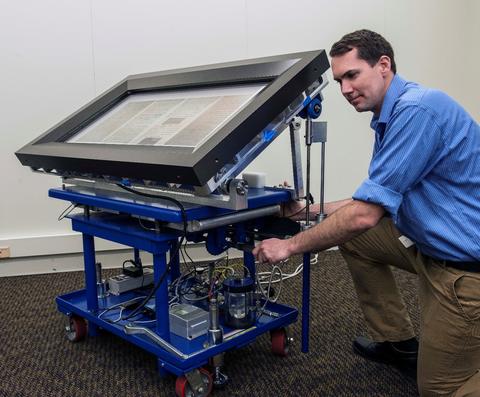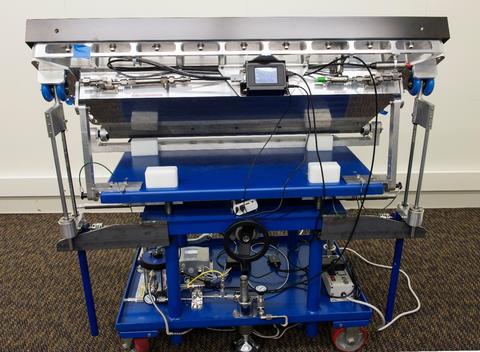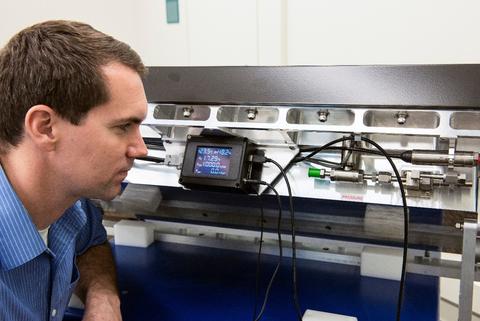
NIST scientist Jacob Ricker demonstrates how the encasement is elevated to a given angle. The document inside is a facsimile of the Preliminary Emancipation Proclamation.
President Abraham Lincoln’s first handwritten draft of the Preliminary Emancipation Proclamation, a historic document in the collection of the New York State Library and New York State Education Department (NYSED), will soon be encased in a new high-tech “home.” Like so many of the nation’s most precious historical documents, including the Charters of Freedom, it will be protected by an encasement system custom-designed and constructed by NIST.
The case, which is still being rigorously tested before final inspection by NYSED, is one of the first that NIST scientists have equipped with a 24/7 sensor monitoring system.
“The system tracks pressure, temperature, relative humidity, and oxygen content, and updates every 15 minutes,” says NIST pressure/vacuum scientist Jacob Ricker. “That kind of monitoring is less important for documents stored at a single location where historical data can be used to anticipate changes in weather. But it’s essential for encasements that are going to travel and thus experience a range of changes in the environment and potential shocks during transport.”
“In addition, many encasements are displayed so that the sensors and back of the encasement are hard to get to. So, it’s convenient to have continuously updated monitoring data stored on a cloud server and be able to plot the data over time. If there’s a serious change, the system will send an email to NYSED so that they can take immediate action as appropriate. This saves significant staff time and makes it much simpler for the encasement users.”

The encasement is made from two halves that were precision milled from a solid block of aluminum and fit together in a sandwich configuration. “We started with about 690 pounds of metal,” says Mark Luce, Director of NIST's Fabrication Technology Group, “and cut away approximately 70%. One of the most critical aspects of the machining was the back of the Base component, which is about 3/32nds of an inch thick. It must be flexible to compensate for most of the changes in atmospheric pressure by bending in and out to alleviate strain on the glass.
The sequence of events in the machining process is critical for the components to remain stable and within the design tolerances throughout the process. In the end, the tolerances range from plus or minus 1/1000th of an inch up to 25/1000th and the biggest challenge is ensuring that when you go to assemble it, everything lines up exactly as designed.”
Inside the encasement, beneath the heavy two-pane laminated glass cover, the chamber is mostly filled with argon, an inert gas used, among other things, in old-fashioned incandescent light bulbs. Two large O-rings provide the seal between the two halves of the case. The integrity is tested by filling the case with helium and checking for leaks.
“Traditionally, document-preservation cases are typically filled with a pure inert gas,” says Jay Hendricks, leader of NIST’s Thermodynamic Metrology Group. “But the NYSED experts specified that 4% oxygen be left in the environment. They told us that the color of the iron gall ink* on the document can change very gradually in the absence of oxygen.”

That’s why the array of sensors attached to the case include one port for instruments that measure oxygen levels. All the sensor output is routed to an onboard suite of electronics that sits on the bottom level of the cart NIST designed and constructed according to NYSED’s dimension requirements. Every other feature of the cart is designed for manual operation, including a hand crank that elevates the encasement to the desired viewing angle.
“We wanted to see to it that operation did not require any hydraulics or electric motors,” Ricker says. “That should minimize the amount of maintenance required and eliminates the possibility of damaging this priceless document.”
* Iron gall ink, a very old formulation which was widely employed around the world well into the 20th century, is a combination of iron sulfate and the dark tannins extracted from galls that form on oak trees. It was in common use in America during Lincoln’s era.

